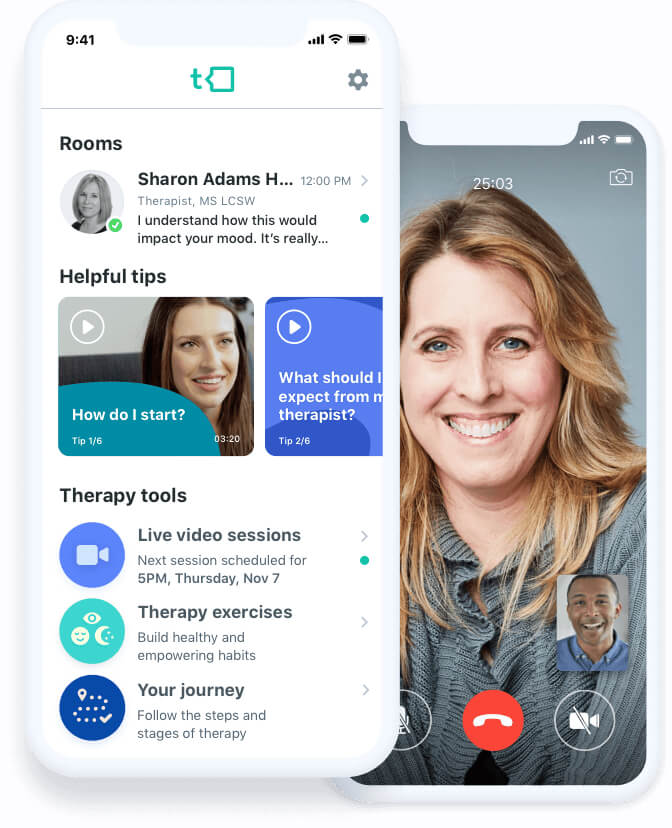
Borderline Personality Disorder (BPD) test
You are not alone

You deserve to feel better

Change starts with a single step

Talkspace is confidential, convenient, and affordable

Begin the borderline personality disorder test
Begin the borderline personality disorder test
FREQUENTLY ASKED QUESTIONS
How is BPD diagnosed?
Borderline Personality Disorder (BPD) is diagnosed by a licensed mental health professional after a thorough assessment of your symptoms, lifestyle, and health history. Your Talkspace provider will conduct a borderline personality disorder screening to provide a full diagnosis using the criteria in the American Psychiatric Association's Diagnostic and Statistical Manual of Mental Disorders or DSM-5.
Taking our online border personality disorder test can help you identify symptoms within yourself. Share these insights with a mental health professional to receive an accurate diagnosis and specialized BPD treatment plan.
Is online therapy an effective treatment option for BPD?
Online therapy is an effective treatment for BPD as long as your therapist or mental health provider has experience and training in this condition. BPD is often treated with Dialectical Behavior Therapy (DBT), Cognitive Behavior Therapy (CBT), and Psychodynamic therapy. Medication is typically not the primary treatment for BPD, but you may be prescribed medication to address specific symptoms.
With the right treatment plan, many people with borderline personality disorder see noticeable improvement in their symptoms over time. Online therapy platforms like Talkspace help connect you with a skilled, trained therapist to help you treat borderline personality disorder from anywhere, at any time. Plus, Talkspace offers online therapy and psychiatry plans that take insurance, making BPD treatment more accessible and affordable than ever before.
How do you get tested for BPD?
You can get tested for BPD by participating in an interview with a mental health provider. Keep in mind that:
- There is no single test to determine definitively if you have BPD, but a mental health provider may use screening tools to assess your symptoms.
- Borderline Personality Disorder often occurs with other mental health disorders such as eating disorders, substance use disorders, depression, anxiety disorders, and bipolar disorder.
- Symptoms of BPD may overlap with other mental health conditions. It is also important to visit your primary care doctor to rule out any underlying physical conditions that could be impacting your mood and behavior.
How long does a BPD diagnosis take?
A BPD diagnosis may be given after one session or several sessions with a mental health provider, depending on how long it takes for your clinician to conduct a thorough assessment. If your symptoms indicate other conditions, or you have underlying medical concerns such as a previous head injury or concussion, your mental health provider may refer you to a specialist or another medical professional for additional information.
What happens if BPD is left untreated?
If BPD is left untreated, those with the condition will continue to experience mood swings, poor self-image, an increased risk of self-harm, unstable relationships, and destructive behavior. People with BPD who do not receive treatment are more likely to develop other chronic medical and mental health conditions.
Will my BPD ever go away?
Borderline Personality Disorder is known for being difficult to treat. While BPD may not go away, it can be managed. There are new evidence-based treatments that have been shown to reduce symptoms and improve the quality of life for individuals with the disorder.
What are the symptoms of borderline personality disorder?
Borderline personality disorder is a mental health condition characterized by self-esteem issues, difficulty managing emotions, and a tendency to view scenarios in the extreme.
Common symptoms of BPD can include, but are not limited to:
- Difficulty maintaining interpersonal relationships
- Thoughts of self-harm
- Paranoia
- Impulsive behavior
- Fear of abandonment
- Extreme and intense anger
- Jealousy
- Suicidal behavior
Symptoms can vary based on the person and type of personality disorder experienced; the different types of BPD include:
- Discouraged borderline personality disorder (also known as high functioning or “quiet” BPD)
- Impulsive borderline personality disorder
- Petulant borderline personality disorder
- Self-destructive borderline personality disorder
How do I know if I have BPD or another mental health condition?
Making an accurate diagnosis can be difficult given the overlapping nature of BPD symptoms with other mental health conditions, including bipolar disorder, depression, or anxiety.
Taking a BPD test acts as a great first step to gaining clarity and understanding your symptoms. From there, it's essential to collaborate with a licensed mental health professional that uses evidence-based treatment options.
What does a BPD episode look like, and what triggers BPD rage?
Emotional instability is a key symptom of BPD. It can be difficult for people with BPD to manage their intense emotions, leading to mood swings, outbursts, and “BPD rage."
People with BPD typically experience triggers that lead to a BPD episode. While triggers are unique to each individual, common examples of BPD triggers include the following:
- Feeling rejected or abandoned in a relationship
- Traumatic memories, especially from adult or childhood trauma
- Criticism through disapproval or negative feedback
- Intrapersonal conflicts through arguments or disagreements




